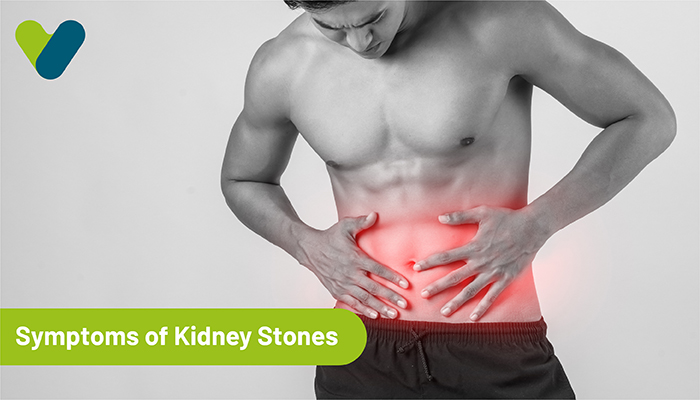What are kidneys and their functions?
The kidneys are a pair of bean-shaped reddish-brown organs situated in the abdomen on either side of the spine. They are about the size of a fist or about 10 to 15 cm. The kidneys' primary function is to filter waste from the blood. The waste is then removed from the body as urine. The kidneys are an integral part of the human body’s urinary system.
What are kidney stones?
Everyone must have heard of people experiencing kidney stones. But what exactly are they? These stones, which can range sizes from a sand grain to a golf ball, are formed when the debris from the urine crystallises and becomes solid. The debris is usually made of minerals and salts like calcium, oxalate, urate, cystine, xanthine, and phosphate. Typically, these substances are absorbed in the urine and passed out of the body. But when they do not, they slowly build up and, over time, turn into kidney stones.
Small stones can pass through the urine by themselves and rarely cause pain. Large kidney stones, on the other hand, can cause considerable discomfort and may necessitate their surgical removal. Besides size, these stones can also vary in colour, density, location, and shape. Kidney stones can be yellow or brown in colour, but some have been found to be black and tan too.
Not all kidney stones elicit symptoms, some simply pass through a system without the person ever knowing of their presence. Some are caused by lifestyle choices and a genetic predisposition, while some can be because of infections like UTIs (urinary tract infections). People who are obese, eat high protein diets (especially animal protein), and eat foods high in fructose are also vulnerable to kidney stone disease. People with gout can also develop kidney stone.
Kidney stones symptoms
There is a common misconception that kidney stones are more common in men. However, that is not true. Women are also increasingly experiencing kidney stones. Around 11% men and 6% women will have kidney stones at least once in their lives. Kidney stones symptoms in men and women are similar.
• The tell-tale renal calculi symptom is pain. These kidney stone symptoms in women and men are the same. The pain can be of varying intensity depending on the size, shape, and density of the stone.
• If a kidney stone does not pass, then it can be stuck in the ureter leading to pain that fluctuates in intensity, discomfort while urinating, and pain in the abdomen and below the ribs.
• One may also see blood in the urine. The colour of urine can be different from usual yellow, pale yellow or clear to pink, brown or even red.
• A patient may also notice that their urine has a foul odour or is cloudy.
• If an infection is causing the kidney stones, then it’s possible that to experience fever and chills. This is the body’s autoimmune response against the foreign invaders that are causing the illness.
• One may even have a persistent urge to urinate but without the satisfaction of completely emptying their bladder.
• Discomforting while urinating may also bring an unpleasant, burning sensation.
Kidney Stone Symptoms by Stone Location or Type
Small vs large stones
Small kidney stone symptoms cause significantly fewer symptoms when compared to large kidney stones. They often go undetected and pass through the body in your urine. Large kidney stones show symptoms such as severe pain in the tummy or groin that comes in waves (men may feel the pain in their testicles), high fever, excessive sweating, nausea or vomiting, blood in the urine, urine infections, etc.
Ureter vs. Bladder
Kidney stones in the bladder can go undetected if they are small. On rare occasions, a large one may occur but cause no problems. If a stone irritates the bladder wall or blocks the urine flow, that is when more severe symptoms may begin occurring:
- Lower abdominal pain
- Painful urination
- Frequent urination
- Difficult urination
- Bloody urine
- Cloudy or unusually dark urine
If the stones are in the ureter, the following symptoms may occur:
- Severe intermittent pain, particularly in the back or under the lower ribs.
- Pain that radiates to the lower abdomen.
- Burning sensation when urinating
- Nausea and vomiting
- Bloody or cloudy urine
- Irregular or reduced urination
Why should everyone know about signs and symptoms of kidney stones?
Kidney stones are a common occurrence, but they are also easy to treat. Learning about the early signs of kidney stones like a sharp pain usually on one side of the abdomen, burning sensation while urinating, and the feeling of incomplete urination can help one recognise the condition quickly.
Knowing the signs and symptoms can prevent the situation from worsening into something that may require a long-term treatment course. With knowledge, people can also avoid pain, worry, and multiple visits to the doctor as well as save money.
If the kidney stones are not treated, they will block the flow of urine and affect the kidney function. The stones can also lead to bacteria build-up from the blocked urine; so, the patient will be at a risk of developing a UTI. Kidney failure is a real possibility if the stones go unaddressed for a long time. Kidney stones can also block the ureters or make them narrow.
One of the best ways to reduce the chances of long-term complications is to have the kidney stones examined and treated.
When to See a Doctor?
Kidney stones can, sometimes, go undetected. However, this does not mean that they cannot become more harmful. It is best to consult a doctor for your kidney stones under the following circumstances:
- You are experiencing pain during urination.
- Your urine is red, pinkish, or brown colored.
- Your urine has a foul smell or appears cloudy.
- You are experiencing pain that comes in waves and varies in intensity.
- You have pain in your back or sides.
- You feel nauseous or are actively vomiting.
- You have a fever and chills.
Kidney stones can often have overlapping symptoms with other illnesses, so it is best to consult a doctor if you have one or more of these symptoms. In emergency cases, seek help immediately. Emergency cases may look like severe pain, vomiting, difficulty urinating, and visible blood in the urine.
How can I treat symptoms of kidney stones?
Oftentimes one may not even know that they have kidney stones because the stones are so small that they leave the body without giving a hint of their presence. Large stones, however, can be a great cause of worry and pain.
Adults and children receive the same treatment for kidney stones. It is recommended that a patient should drink plenty of water to avoid dehydration and to pass the stone through their urine without passing out. Then, there are medications that lower the level of uric acid in the blood. Alpha blockers, which relax the ureter and enable the stone to pass without discomfort or pain, may be prescribed.
For large stones, there are minimally invasive and surgical techniques for removal. However, these methods do not eliminate the chances of kidney stones recurring.
Preventing Future Kidney Stones
The best way to avoid kidney stones is to drink plenty of water every day to avoid dehydration. Keep the urine diluted enough to prevent waste products from becoming over concentrated, leading to stone formation. The colour of the urine indicates how diluted it is.
The urine is more concentrated with waste if it is darker in colour. Because of the accumulation of waste products that a body has produced over the course of the night, the urine is typically a dark yellow colour in the morning. Tea, coffee, and fruit juices can all contribute to hydration quota, but water is always the best alternative. People should also hydrate when it's warm outside or when they are staying active to replace fluids lost when they sweat.
Moreover, people can make dietary adjustments like only having moderate amounts of protein dense foods and consult with their doctor to adjust the medications if the medicines are the suspected reasons behind the stones.
People who have already undergone treatment for kidney stones need to maintain a lifestyle that does not encourage kidney stone formation along with regular check-ups and monitoring of their kidneys.


